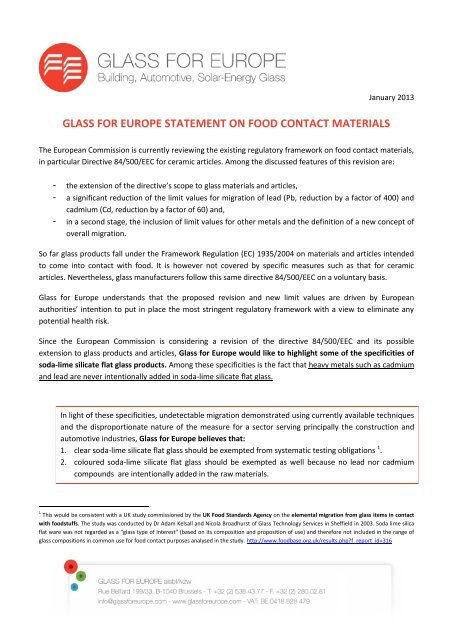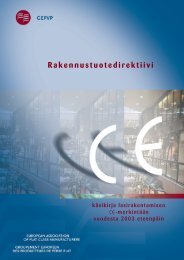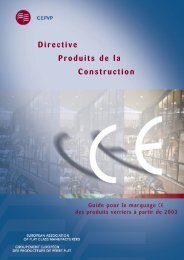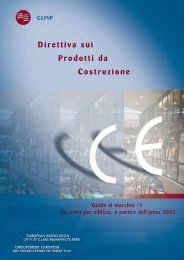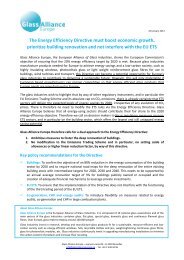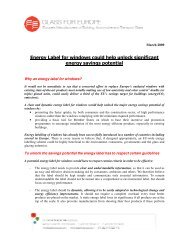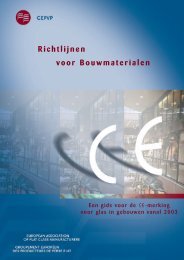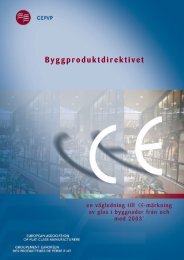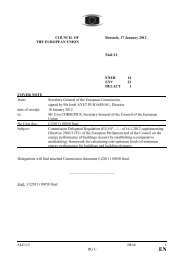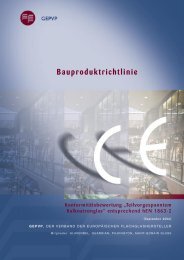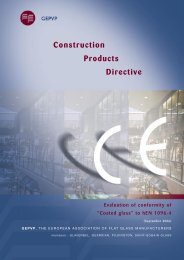glass for europe statement on food contact materials
glass for europe statement on food contact materials
glass for europe statement on food contact materials
- No tags were found...
You also want an ePaper? Increase the reach of your titles
YUMPU automatically turns print PDFs into web optimized ePapers that Google loves.
January 2013GLASS FOR EUROPE STATEMENT ON FOOD CONTACT MATERIALSThe European Commissi<strong>on</strong> is currently reviewing the existing regulatory framework <strong>on</strong> <strong>food</strong> c<strong>on</strong>tact <strong>materials</strong>,in particular Directive 84/500/EEC <str<strong>on</strong>g>for</str<strong>on</strong>g> ceramic articles. Am<strong>on</strong>g the discussed features of this revisi<strong>on</strong> are:- the extensi<strong>on</strong> of the directive’s scope to <str<strong>on</strong>g>glass</str<strong>on</strong>g> <strong>materials</strong> and articles,- a significant reducti<strong>on</strong> of the limit values <str<strong>on</strong>g>for</str<strong>on</strong>g> migrati<strong>on</strong> of lead (Pb, reducti<strong>on</strong> by a factor of 400) andcadmium (Cd, reducti<strong>on</strong> by a factor of 60) and,- in a sec<strong>on</strong>d stage, the inclusi<strong>on</strong> of limit values <str<strong>on</strong>g>for</str<strong>on</strong>g> other metals and the definiti<strong>on</strong> of a new c<strong>on</strong>cept ofoverall migrati<strong>on</strong>.So far <str<strong>on</strong>g>glass</str<strong>on</strong>g> products fall under the Framework Regulati<strong>on</strong> (EC) 1935/2004 <strong>on</strong> <strong>materials</strong> and articles intendedto come into c<strong>on</strong>tact with <strong>food</strong>. It is however not covered by specific measures such as that <str<strong>on</strong>g>for</str<strong>on</strong>g> ceramicarticles. Nevertheless, <str<strong>on</strong>g>glass</str<strong>on</strong>g> manufacturers follow this same directive 84/500/EEC <strong>on</strong> a voluntary basis.Glass <str<strong>on</strong>g>for</str<strong>on</strong>g> Europe understands that the proposed revisi<strong>on</strong> and new limit values are driven by Europeanauthorities’ intenti<strong>on</strong> to put in place the most stringent regulatory framework with a view to eliminate anypotential health risk.Since the European Commissi<strong>on</strong> is c<strong>on</strong>sidering a revisi<strong>on</strong> of the directive 84/500/EEC and its possibleextensi<strong>on</strong> to <str<strong>on</strong>g>glass</str<strong>on</strong>g> products and articles, Glass <str<strong>on</strong>g>for</str<strong>on</strong>g> Europe would like to highlight some of the specificities ofsoda-lime silicate flat <str<strong>on</strong>g>glass</str<strong>on</strong>g> products. Am<strong>on</strong>g these specificities is the fact that heavy metals such as cadmiumand lead are never intenti<strong>on</strong>ally added in soda-lime silicate flat <str<strong>on</strong>g>glass</str<strong>on</strong>g>.In light of these specificities, undetectable migrati<strong>on</strong> dem<strong>on</strong>strated using currently available techniquesand the disproporti<strong>on</strong>ate nature of the measure <str<strong>on</strong>g>for</str<strong>on</strong>g> a sector serving principally the c<strong>on</strong>structi<strong>on</strong> andautomotive industries, Glass <str<strong>on</strong>g>for</str<strong>on</strong>g> Europe believes that:1. clear soda-lime silicate flat <str<strong>on</strong>g>glass</str<strong>on</strong>g> should be exempted from systematic testing obligati<strong>on</strong>s 1 .2. coloured soda-lime silicate flat <str<strong>on</strong>g>glass</str<strong>on</strong>g> should be exempted as well because no lead nor cadmiumcompounds are intenti<strong>on</strong>ally added in the raw <strong>materials</strong>.1 This would be c<strong>on</strong>sistent with a UK study commissi<strong>on</strong>ed by the UK Food Standards Agency <strong>on</strong> the elemental migrati<strong>on</strong> from <str<strong>on</strong>g>glass</str<strong>on</strong>g> items in c<strong>on</strong>tactwith <strong>food</strong>stuffs. The study was c<strong>on</strong>ducted by Dr Adam Kelsall and Nicola Broadhurst of Glass Technology Services in Sheffield in 2003. Soda lime silicaflat ware was not regarded as a “<str<strong>on</strong>g>glass</str<strong>on</strong>g> type of interest” (based <strong>on</strong> its compositi<strong>on</strong> and propositi<strong>on</strong> of use) and there<str<strong>on</strong>g>for</str<strong>on</strong>g>e not included in the range of<str<strong>on</strong>g>glass</str<strong>on</strong>g> compositi<strong>on</strong>s in comm<strong>on</strong> use <str<strong>on</strong>g>for</str<strong>on</strong>g> <strong>food</strong> c<strong>on</strong>tact purposes analysed in the study. http://www.<strong>food</strong>base.org.uk/results.php?f_report_id=316
Use of flat <str<strong>on</strong>g>glass</str<strong>on</strong>g> <str<strong>on</strong>g>for</str<strong>on</strong>g> <strong>food</strong> applicati<strong>on</strong>s is really very limited and rare: flat <str<strong>on</strong>g>glass</str<strong>on</strong>g> is mostly used inbuildings, automotive and solar energy modulesMore than 99% of flat <str<strong>on</strong>g>glass</str<strong>on</strong>g> producti<strong>on</strong> is used <str<strong>on</strong>g>for</str<strong>on</strong>g> windows, facades, automotive <str<strong>on</strong>g>glass</str<strong>on</strong>g> and solar energymodules. Only a very small fracti<strong>on</strong> of flat <str<strong>on</strong>g>glass</str<strong>on</strong>g> producti<strong>on</strong> (much lower than 1% c<strong>on</strong>sidering all otherapplicati<strong>on</strong>s) is used in products intended <str<strong>on</strong>g>for</str<strong>on</strong>g> <strong>food</strong> c<strong>on</strong>tact. Am<strong>on</strong>g this limited number of articles can be citedcutting boards, decorative serving plates, tables and counter tops, fridge shelves, etc.Although quantities of flat <str<strong>on</strong>g>glass</str<strong>on</strong>g> products that may have <strong>food</strong> c<strong>on</strong>tact applicati<strong>on</strong> are almost negligible,dem<strong>on</strong>strati<strong>on</strong> of compliance with new limit values would be required <str<strong>on</strong>g>for</str<strong>on</strong>g> the full flat <str<strong>on</strong>g>glass</str<strong>on</strong>g> producti<strong>on</strong>(over 9 milli<strong>on</strong> t<strong>on</strong>nes in the EU), as products’ final destinati<strong>on</strong> and usage are not known to the flat <str<strong>on</strong>g>glass</str<strong>on</strong>g>producer at the time of producti<strong>on</strong>.Absence of health hazardTesting nowadays per<str<strong>on</strong>g>for</str<strong>on</strong>g>med by flat <str<strong>on</strong>g>glass</str<strong>on</strong>g> companies in order to dem<strong>on</strong>strate compliance with the existingmigrati<strong>on</strong> limits have c<strong>on</strong>sistently c<strong>on</strong>firmed, with large c<strong>on</strong>fidence, compliance with the limits. Indeed allresults are below the quantificati<strong>on</strong> limits of the analytical equipments comm<strong>on</strong>ly used in laboratories.In fact, characterizati<strong>on</strong> testing per<str<strong>on</strong>g>for</str<strong>on</strong>g>med <strong>on</strong> flat <str<strong>on</strong>g>glass</str<strong>on</strong>g> products have c<strong>on</strong>sistently showed heavy metalstraces within flat <str<strong>on</strong>g>glass</str<strong>on</strong>g> products that are at least between 10 to 100 times lower than the most stringentregulatory limits already set by the EC packaging directive <str<strong>on</strong>g>for</str<strong>on</strong>g> c<strong>on</strong>tainers of all types, whose primarypurpose, unlike flat <str<strong>on</strong>g>glass</str<strong>on</strong>g>, is to preserve <strong>food</strong>, ingredients and drinks.Testing c<strong>on</strong>diti<strong>on</strong>s not fit to the reality of <strong>food</strong> c<strong>on</strong>tact of flat <str<strong>on</strong>g>glass</str<strong>on</strong>g> productsUnlike other articles potentially targeted by the directive, flat <str<strong>on</strong>g>glass</str<strong>on</strong>g> products that are used <str<strong>on</strong>g>for</str<strong>on</strong>g> <strong>food</strong> c<strong>on</strong>tactpurposes are usually meant <str<strong>on</strong>g>for</str<strong>on</strong>g> short-c<strong>on</strong>tact times and a c<strong>on</strong>tact with <strong>food</strong> in the solid state <strong>on</strong>ly. Theprescribed testing c<strong>on</strong>diti<strong>on</strong>s (24h c<strong>on</strong>tact at 22 °C in 4% acetic acid) are not representative of a solidexchange 2 . Such test c<strong>on</strong>diti<strong>on</strong>s would there<str<strong>on</strong>g>for</str<strong>on</strong>g>e lead to a major overestimate of the real migrati<strong>on</strong> and thusexposure of c<strong>on</strong>sumers.A disproporti<strong>on</strong>ate burden <strong>on</strong> producers <str<strong>on</strong>g>for</str<strong>on</strong>g> no public health benefitRec<strong>on</strong>firming compliance to the newly proposed limits cannot be per<str<strong>on</strong>g>for</str<strong>on</strong>g>med internally by companies since thenew limit values <str<strong>on</strong>g>for</str<strong>on</strong>g> lead and cadmium migrati<strong>on</strong> requires specific testing c<strong>on</strong>diti<strong>on</strong>s including the use ofultra-pure reagents, clean rooms and the most advanced equipments in terms of accuracy. It would there<str<strong>on</strong>g>for</str<strong>on</strong>g>erequire the testing to be d<strong>on</strong>e by specialized external laboratories that present appropriate equipments andexpertise to per<str<strong>on</strong>g>for</str<strong>on</strong>g>m this testing.2 For instance, tests provide results per liter and c<strong>on</strong>versi<strong>on</strong> factors have to be used <str<strong>on</strong>g>for</str<strong>on</strong>g> flat ware. The c<strong>on</strong>versi<strong>on</strong> factor is based <strong>on</strong> a factor of 6 fromliters to square decimeters (c<strong>on</strong>sidering the sum of the areas of the 6 faces of a cube of 1 liter), which implies a c<strong>on</strong>tact with all faces and the entirearea of each of the 6 faces, which simply cannot physically happen while using products made of flat <str<strong>on</strong>g>glass</str<strong>on</strong>g>.Glass <str<strong>on</strong>g>for</str<strong>on</strong>g> Europe <str<strong>on</strong>g>statement</str<strong>on</strong>g> <strong>on</strong> Food C<strong>on</strong>tact Materials – January 2013 Page | 2


